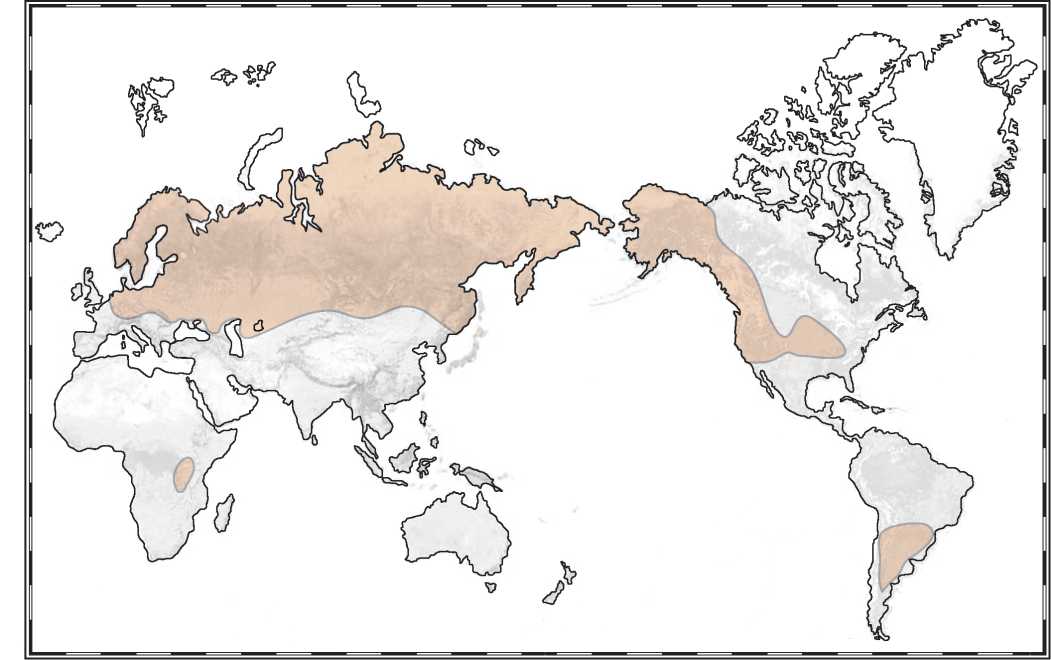Prior to modern times, the people from Finland to Arizona constituted a vast cultural continuum, the largest and most durable in the history of mankind. It was, of course, not a single culture that made up this continuum and not even a single genetic strand. Nonetheless, a Navajo woman living in the deserts of Arizona around 1600 ce, would have had no difficulty understanding the way of life of the Sami of Finland, some 13,000 kilometers away, had she been somehow transported there, and this despite differences in language and ritual practice. Even their pit houses were similarly constructed. Had this person also been transported back in time to 7000 bce northern China, she also would have fit in quite easily. Within this continuum there are a number of subcontinuities such as those between arctic seafaring peoples, between big game hunters, and between riverine cultures. But even across these important divides, there were unmistakable connections (Figure 4.1).
Figure 4.1: Areas where pit houses were built around the world. Source: Florence Guiraud

What made this continuity prosper over such vast stretches of time, geography, and genetics was a relatively common ecology of taiga and conifer forests, bounded by steppes, plains, and shores, and cut through by rivers and lakes. Although it included the deciduous forest in the eastern United States and Canada, there were no rainforests and no large deserts to significantly alter traditional habits. These people all specialized in dealing with the complex, interlocking rhythms of animal and bird migrations, and of fish spawning, whale movements, and plant ripenings; they lived for the most part in relation to dark winters, wet springs, and dry falls. All of these societies had a culture of clothing that was not just for practical purposes. These societies also had strong relationships to animals that could define a person’s core being. The concept of describing bears, eagles, or mountain lions as “wild” would be incomprehensible in these cultures. Animals gave shape to a cosmological energy that pervaded everything. Taboos governed how they had to be hunted and even consumed. This continuum did not come to a halt at the great rainforests of the Americas. On the contrary, it continued, and indeed the shaman cultures of the Amazon have certain undeniable similarities with Siberian shaman cultures and are an extension of this phenomenon.
Contributing to the continuity was the absence of any prolonged interaction with agriculturalists. The great agricultural revolution that began around 6000 bce in Eurasia remained relatively separated from the northern world. Deserts and mountains formed a barrier against agriculture in some places even until modern times. In the Americas, agriculture did not make its way north until about 800 ce and even then only barely penetrated into Canada.
Another factor that preserved this continuity was the absence of metal. Copper was mined in Alaska and Michigan and made into prestige objects that filtered their way into the regional exchange networks, but this did not alter political structures in any appreciable way, nor did it undermine the central role that the shaman played in all these cultures.1 By way of comparison, the use of metal and agriculture in central and northwest South America and in Mesopotamia and Europe fundamentally changed the historical trajectory of those places. A social structure with no agriculture and no metal was perfectly suited to replicate its core cosmological system over thousands of years and yet in each case develop unique, regional responses to resources, ecology, and trade.
Property among these peoples does come to play a role, but remained very difierent from the modern concept where property is ofi:en associated with the private domain. Among First Societies, property was associated with rights to control certain things, such as hunting and fishing grounds, but it also extended to the usage of symbols and stories. Furthermore, wealth was not to be stored away in a vault, but was shared and distributed to members of the family and, during yearly festivals, given away. Bit by bit, in difierent places and in difierent times, countries, empires, and finally the modern nation states of the world chopped this continuum up into fragmented bits. Repression was the norm, whether it be Russia, and later the Soviet Union, Canada, the United States, or Brazil. In the Americas, disease wiped out millions. All that is left: today are a few remnant examples of “living traditions,” illuminated—still inconsistently—by a growing body of archaeological and anthropological studies.




 World History
World History









